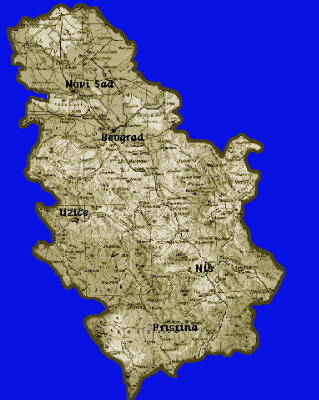

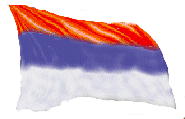
SERBIA
Serbia is situated in the southeastern
part of Europe. It covers the central part of the Balkan Peninsula. The
northern part of the Republic is lowland and the southern parts are hilly
and mountainous. There are more than 15 mountain peaks rising to over 2,000
metres above sea level. The navigable rivers are the Danube, Sava
and Tisa. A moderate continental climate predominates.
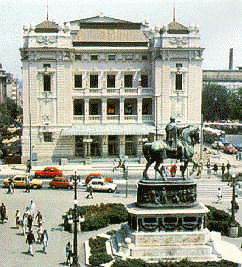
INTRODUCTION
The capital of the Republic of Serbia is Belgrade.
The official language is Serbian.
The Cyrillic is the official alphabet.
Belgrade, The Church of St. Sava
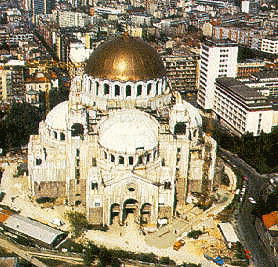
The largest religious community is the Serbian Orthodox but
there are also Islamic, Roman Catholic, Protestant, Jewish and other
religious communities.
In the political life of Serbia is established a multi-party political system.
Panorama
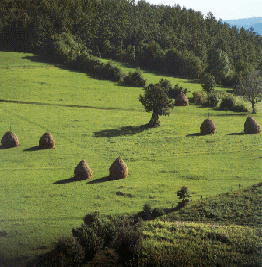
The major part of the Republic's national income is earned throught industry
and agriculture.
But agriculture has remained a predominent economic activity. Energy
is the second important product in Serbia. Nonferrous metals are the third
largest product group, such as copper, lead, zinc, silver and gold. In the past, Serbia
has been oriented toward food, chemical, electronic and other industries.
Manasia Monastery
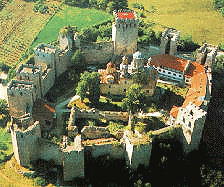
The great variety of beautiful scenery and cultural and historical
monuments, curative spas, hunting grounds and fishing areas give the basis
for Serbia's tourism. International roads and railway lines link Western
and Central Europe with Greece, Turkey, the Near East, Asia and Africa.
The main air transport routes between West and East and North and South
cross this country, too.
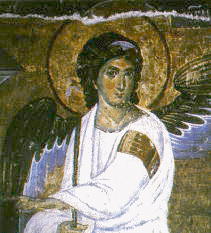
White Angel
The Serbian lands were the crossroads of various civilizations
in the past, with different spiritual, architectural, artistic and cultural
influences. Serbian cultural and historical heritage is diverse because of these influences.
The numerous prehistoric and classical monuments represent some unique examples of the
changing times. Serbia is enhanced by natural beauty and geographic contrasts.
The Danube River
Panorama
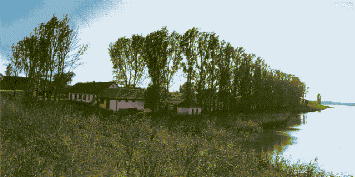 In
the North there is a fertile and vast prairie, a part of the Pannonian Plain.
It is lowland relief with Fruska Gora hills. The Central Serbia is rolling
region hills with fields, hedges, orchards and meadows. Southern Serbia
has big mountain ranges with wide river valleys and hollows. The altitude
of some of the mountains is over 2,500 m.
In
the North there is a fertile and vast prairie, a part of the Pannonian Plain.
It is lowland relief with Fruska Gora hills. The Central Serbia is rolling
region hills with fields, hedges, orchards and meadows. Southern Serbia
has big mountain ranges with wide river valleys and hollows. The altitude
of some of the mountains is over 2,500 m.
Eastern Serbia is covered with mountains which belong to the Carpathian and to the Balkan mountain system. Here the Danube river cuts the Kazan, the longest and narrowest part of the Djerdap Gorge. Western Serbia is another mountainous region, with many picturesque canyons, forests and great natural and climatic advantages. Waters in Serbia - rivers, lakes, artificial lakes and mineral springs, represent an important natural resource for tourism. The Danube, the largest and the most important waterway in Europe flows through Serbia, covering some 591 km inside its borders.
Golubac Fortress
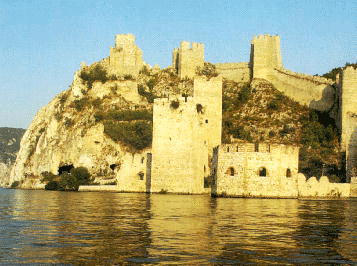 Flora
and fauna are especially attractive. Throughout Serbia there are
numerous animal species and game stock, which is a very favourable precondition
for the hunting tourism. Many tourist resorts have sprung up
with accomodation facilites, ideal for rest and recreation, situated
in this diverse combination of natural and human mightiness. As a tourist
area, Serbia has a very long tradition. For more than 150 years, guests
have been coming to Serbian spas. The current receptive basis of tourism
and catering industry consists of 125,000 beds in basic and supplementary
accomodation facilities. There are nearly 40,000 hotel beds in various classes.
Flora
and fauna are especially attractive. Throughout Serbia there are
numerous animal species and game stock, which is a very favourable precondition
for the hunting tourism. Many tourist resorts have sprung up
with accomodation facilites, ideal for rest and recreation, situated
in this diverse combination of natural and human mightiness. As a tourist
area, Serbia has a very long tradition. For more than 150 years, guests
have been coming to Serbian spas. The current receptive basis of tourism
and catering industry consists of 125,000 beds in basic and supplementary
accomodation facilities. There are nearly 40,000 hotel beds in various classes.
TOWNS, CONVENTION AND CONGRESS FACILITIES
Belgrade, the capital of Serbia, is situated at the confluence of the Sava and the Danube. In the course of its long history it has been captured 60 times. Today, it is a modern city of about a million inhabitants. To visitors Belgrade offers its rich programme of cultural, artistic and sports events, many museums, cultural and historic monuments. With the Sava Congress Centre and numerous hotels, Belgrade has become one of the major congress and convention centres in Europe.
Novi Sad, Petrovaradin
Fortress
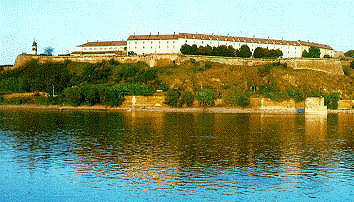
The convention facilities offer the other large towns: Novi Sad, Pristina, Nis, Subotica, Kragujevac, Uzice and Valjevo, as well as the mountain centres: Kopaonik, Tara, Zlatibor, Divcibare, Brezovica, and the spas: Vrnjacka Banja, Niska Banja, Bukovicka Banja, Soko Banja and many others tourists resorts.
Djerdap
Gorge (and a figure from Lepenski vir)
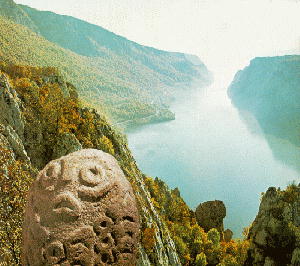 THE DANUBE
RIVER REGION
THE DANUBE
RIVER REGION
Serbia is one of the Danubian countries. The surviving monuments testify about its rich history (Lepenski Vir, the oldest archeological site, Trajan's bridge and Tablet dating from the period when the Danube was the limit of the Roman Empire). There are from the Roman times, also: Gamzigrad with its famous mosaics. Viminacium, then the medieval fortress Smederevo, Golubac, Ram, Fetislam and others. The Djerdap Dam, built jointly in 1964-72 by Yugoslavia and Romania, is one of the most impressive pieces of civil engineering in Europe. The waters of the Danube represent the largest fishing grounds, where fishing and other water sports are practiced.
Castle
of the family Dundjerski
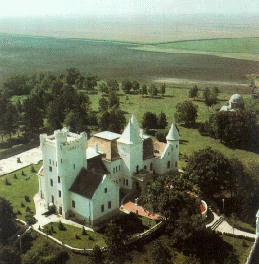 NATIONAL
PARKS
NATIONAL
PARKS
There are two National parks including the gravitational area: Djerdap the National Park and Fruska Gora the National Park, From Golubac to Tekija, on a stretch 100 km long and covering an area of about 62,000 ha lies the Djerdap National Park. In this section the Danube is deepest, widest and narrowest. Two lakes, the Djerdap and the Srebreno are the pearls of the Danube. Fruska Gora, situated between the Sava and Danube rivers, represents the wooded hill in lowland Vojvodina. The total area exceeds 22,000 ha. Fruska Gora is also attractive due to numerous old Serbian monasteries. This region has a long tradition in the production of excellent wines. This area is known by the hunting facilities, too.
Many mineral spring and a large number of well-appointed spas with a long tradition of use going as far back as Roman times, are an important feature of Serbia's tourism. In terms of the number of springs and the quality of the waters these spas are famous in Europe. The combination of natural factors and medical methods in Serbia's modern and specialized centres yields remarkable results in treatment and rehabilitation. Almost all of the spas are situated at the foot of mountains surrounded by wooded hills, and have a mild climate.
 According
to indications for treatment, rest, excursions and the leisure time activities
offered. The most famous are Vrnjacka Banja, with two millennia of tradition
and more than 120 years of organized tourism and health care. The spa has
three mineral water springs, of which one is warm and two are cold. In the
immediate vicinity of this spa there are many important monuments dating
back to the 14th century. Soko Banja is a well known balneological center
from the Roman times, whose development began almost a century ago. The
curative waters come from several spring, the temperatures from 20 to 45
C. Banja Koviljaca, has also been known for centuries. It now ranks among
the well-appointed and modernly equipped natural health resorts. The spa
has several spring of thermo-mineral waters. Mataruska Banja has highly
curative thermo-mineral water, with a temperature from 28 to 50 C. The sulphur-content
of the waters is one of the highest in the world.
According
to indications for treatment, rest, excursions and the leisure time activities
offered. The most famous are Vrnjacka Banja, with two millennia of tradition
and more than 120 years of organized tourism and health care. The spa has
three mineral water springs, of which one is warm and two are cold. In the
immediate vicinity of this spa there are many important monuments dating
back to the 14th century. Soko Banja is a well known balneological center
from the Roman times, whose development began almost a century ago. The
curative waters come from several spring, the temperatures from 20 to 45
C. Banja Koviljaca, has also been known for centuries. It now ranks among
the well-appointed and modernly equipped natural health resorts. The spa
has several spring of thermo-mineral waters. Mataruska Banja has highly
curative thermo-mineral water, with a temperature from 28 to 50 C. The sulphur-content
of the waters is one of the highest in the world.
The Spa of Nis
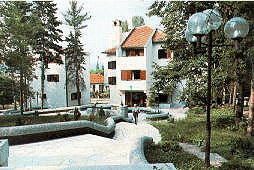 Niska
Banja has a number of thermal and radioactive springs, the temperature
from 19 to 30 C. There are also the remains of Roman and Turkish baths,
apeaking about its history. Bukovicka Banja, Selters Banja, Ovcar Banja,
Junakovic, Sijerinska Banja, Kursumlijska Banja, Gornja Trepca, Bujanovacka
Banja and the others offer a lot of curative, recreative and relaxative
facilities.
Niska
Banja has a number of thermal and radioactive springs, the temperature
from 19 to 30 C. There are also the remains of Roman and Turkish baths,
apeaking about its history. Bukovicka Banja, Selters Banja, Ovcar Banja,
Junakovic, Sijerinska Banja, Kursumlijska Banja, Gornja Trepca, Bujanovacka
Banja and the others offer a lot of curative, recreative and relaxative
facilities.
Zica
Monastery
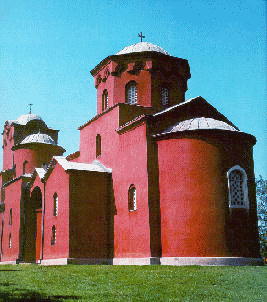 MONUMENTS
OF CULTURE
MONUMENTS
OF CULTURE
Serbia has a rich cultural heritage ranging from the remains of the oldest human settlement Lepenski Vir, 7000 years old, throught the Neolithic site at Vinca, Roman and Byzantine edifices, Tabula Trajana, Gamzigrad, the Belgrade Fortress, Petrovaradin Fortress, to medieval monasteries with their unique architecture and fresco paintings of outstanding beauty from golden age of Serbia in the 12th and 13th centuries. Djurdjevi Stupovi, Zica, the Patriarchate of Pec, Gracanica, Decani, Ljubostinja, Mileseva, Sopocani are some of them.
Patriarchy of Pec
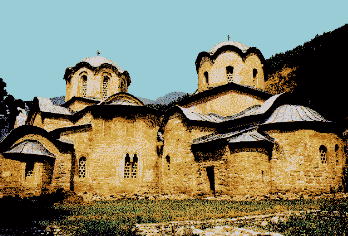
Studenica Monastery and the medieval town of Ras, with the Sopocani
Monastery are included in the list of the world most valuable monuments,
protected by UNESCO.
Kopaonik,
landscape
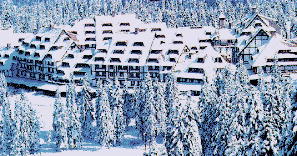 MOUNTAINS
AND WINTER TOURISM
MOUNTAINS
AND WINTER TOURISM
Serbia's mountains are its wealth and its beauty. The joint characteristics of most of its mountains are the vast areas under coniferous and deciduous forests, pastures and meadows, a moderate altitude and very agreable climate for both summer and winter vacations, sports activities and rehabilitation. Kopaonik, Tara, Sara and Fruska Gora have been proclaimed National parks, thanks to their exceptional beauty.
Kopaonik
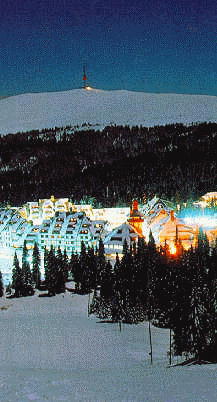
The most developed mountain tourist centre is Kopaonik, 2,017m above sea lavel, a well known winter sport resort. Kopaonik is a mountain giant, about 120 km long and 50 km wide. With a ten year long tradition its ski centre has become established in Europe. It is convenient to all categories of skiers. Kopaonik is not only attractive in the winter. It is also a summer tourist centre. In the surroundings of Kopaonik there are many interesting monasteries as Sopocani, Studenica, Zica, Decani, Patriarchate of Pec, Zupa vine-growing region, gight spas, the Ibar and other rivers.
Zlatibor is a traditional health, recreational and
vocation resort. The Zlatibor plateau is known in Europe as a climatic
resort, and thanks to the modern recreative and preventative programme
it has become popular among the all categories of tourists.
Zlatibor
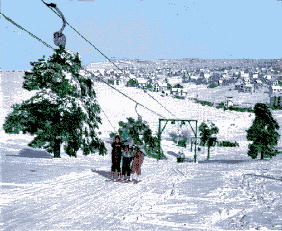 Zlatibor
is already well known as a sport centre. There are ski, golf, riding and
other sports facilities.
Zlatibor
is already well known as a sport centre. There are ski, golf, riding and
other sports facilities.
The Brezovica on the mountain Sara has a lot of similarities with the Alps. Even this fact is sufficeint for the development of modern tourism in the summer and the winter and especially for the development of winter tourism. Mt [ara is about 80 km long with numerous peaks over 2,500 m. covered by snow all the year around. The whole area has an exceptional environment: changing scenery, beautiful valleys, and mountains, picturesque villages and historical monuments. Divcibare, Tara, Vlasina, Goc, Zlatar, Stara Planina, Golija offer the favourable climatic and tourist conditions. But, there are the other mountains resorts offering the facilities for toourism.
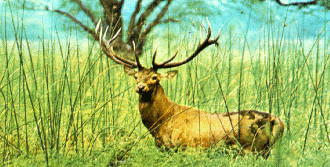 HUNTING
AND FISHING FACILITIES
HUNTING
AND FISHING FACILITIES
Serbia abounds in hunting grounds rich in big and small game. Hunting is possible all the year round depending on the type of game and the grounds. Big game includes bears, deer, wild boars and mouflons.
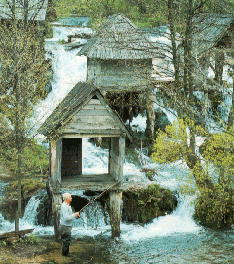
Throught Serbia and especially in Vojvodina exist a lot of small game
species such as hares, pheasant, rabbits, mink and others.
Game bird hunting grounds are also rich.
TRANSIT TOURISM
A trip through Serbia takes the shortest and the most picturesque travel path from Europe to the Middle East and to Eastern Europe. Serbia has many projects for the extension and the renovation roads and for catering facilities along its motorways.